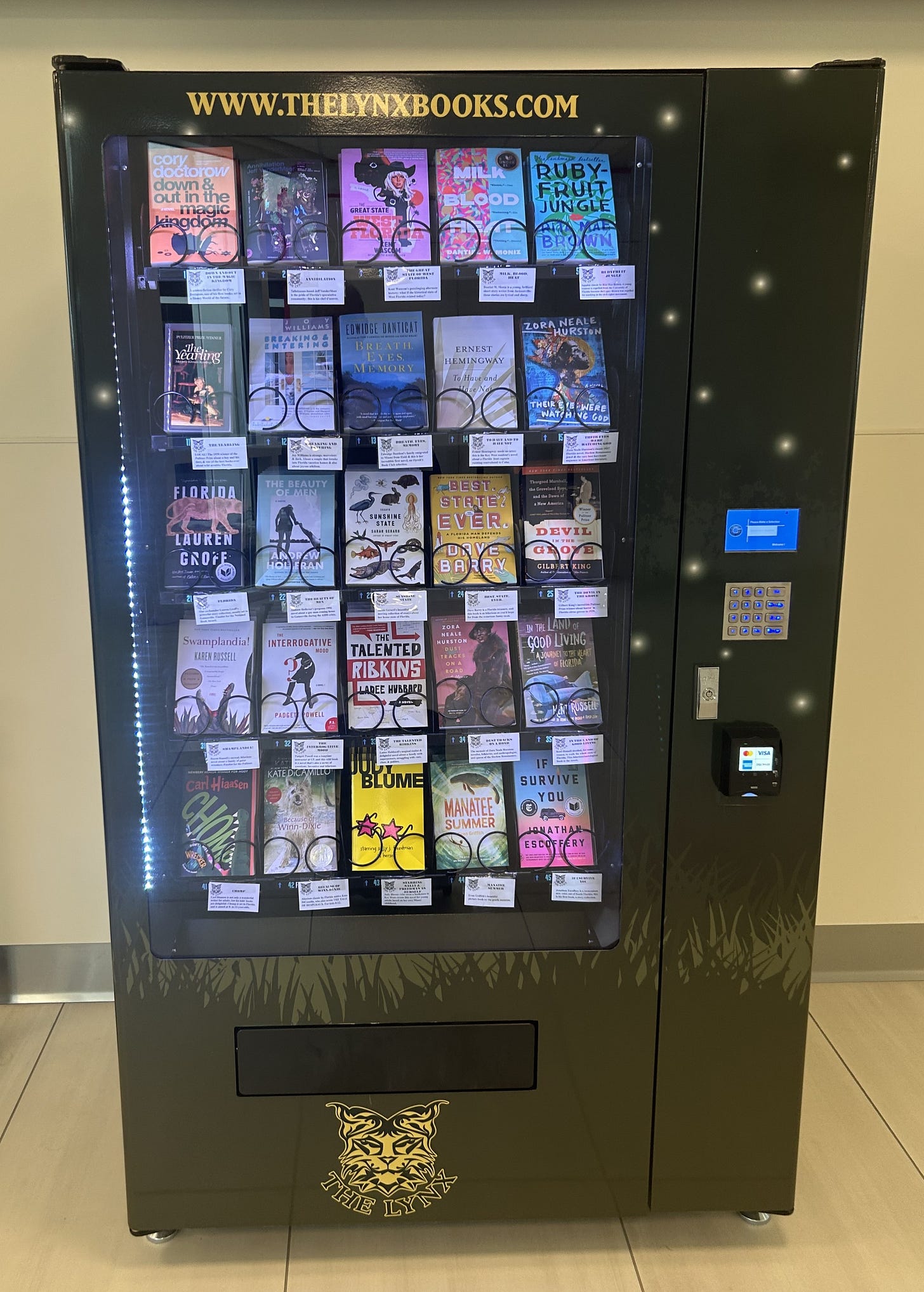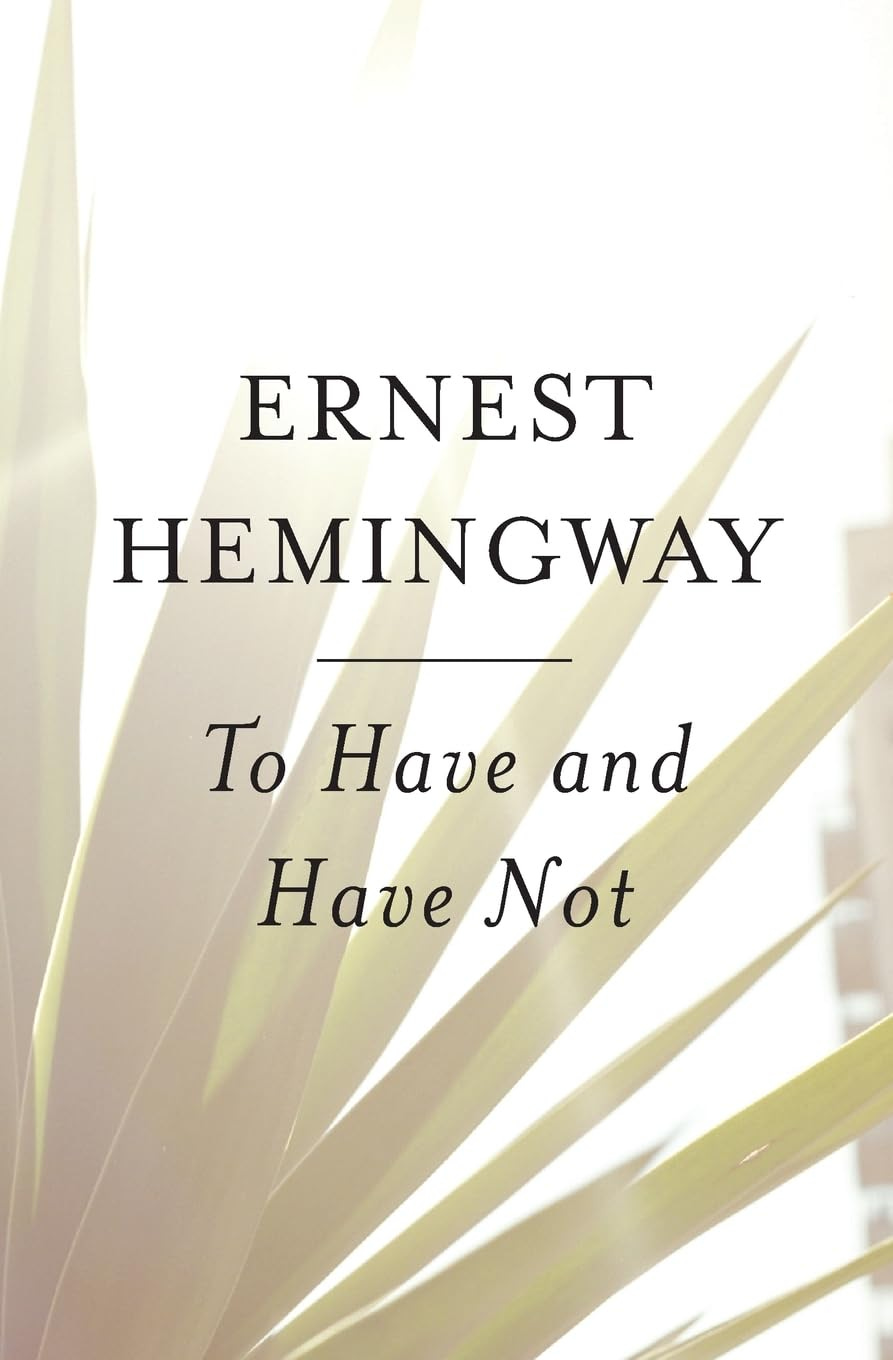Vending Machine Hemingway: Reflections on Place-Based Reading
What can we learn about reading from the books inspired by our travels?
On a humid day in late June, I arrived at the small airport in Gainesville, Florida, with the lightness of step that comes from finishing a speaking engagement and heading home. I had flown into Gainesville the evening before, presented for three hours to a group of veterinary faculty at an education conference the next morning, and was on my way back to the airport by 1:30 pm. Because the trip was so short, I had only brought a short story collection for my travel reading, which I assumed would hold me over for a single night in the hotel, but I had finished it over dinner.
I passed through airport security more than two hours early for my flight and meandered through the concourse hoping that my plane would have seatback screens so I could watch a movie on the way home. But the reflective glass of a vending machine caught my eye—or what looked like a vending machine, except for the fact that it contained no candy or chips. It was filled with books. I went in for a closer look.
My eyes had not deceived me. It was a vending machine for books, one developed by The Lynx Books, one of the co-founders of which is bestselling author Lauren Groff. I scanned the titles and recognized quickly that the books had a theme: Florida. The twenty-five books facing me, all snuggled into their little vending machine coils, were novels, memoirs, and nonfiction books about the people, wildlife, and culture of America’s weirdest state: I saw books by Carl Hiaasen, Dave Barry, Karen Russell, and, of course, Lauren Groff. Predictably, my eyes were drawn to a work of classic literature: Ernest Hemingway’s To Have and Have Not.
Like many young men whose writing ambitions originated in the latter half of the 20th century, I had been through my Hemingway phase. Drinking copiously late into the night, writing in Paris cafes in the early morning, fishing in cold streams in Spain, having love affairs in Key West—it had all seemed pretty good to me in my late teens and early twenties. But it had been a very long time since I had cracked the spine of a Hemingway book, and my dim memories of his work suggested that I would recoil today at some of his attitudes towards gender and sexuality.1
Still, it was literature, and I had a plane ride in front of me, and no pressing work tasks. I tapped my credit card on the machine’s reader, the coils twisted, and To Have and Have Not dropped into the bin at the bottom. I found a quiet area near the gate and began reading. The plane had no screens in the seatbacks, so I kept reading throughout the flight, and part of the next flight as well. By the time I arrived in Boston, I had finished 2/3 of the novel; I finished the remaining 1/3 the next day.
In the days that followed, my mind kept circling back to Hemingway’s Florida: the heat and humidity, the blazing June sun, the afternoon rains, the scudding clouds against a blue sky. Key West (the setting of the novel) is a long way from Gainesville, but those climate features are shared. They are alien enough to a New Englander that they dominate my impression of the state, which I have visited many times in my life. Hemingway’s constant attention to the sun and heat and rains of Florida continued to bring them back to life for me days and weeks after I had left the state, evoking an unexpected nostalgia for a place in which I had just spent just twenty fours.
I could have told you a similar story about many books I have on my shelves. Whenever I travel, I make a point to leave room in my backpack for a newly purchased book that connects to the place I am visiting. I also often read place-based books before the trip begins or hunt one down after I come home. Scanning my shelves, I see a book about the Armenian genocide from my trip to the American University of Armenia ten years ago; a collection of letters from Flannery O’Connor when I spoke at a college in Milledgeville, Georgia (where she lived); from a trip to the Albuquerque, David Roberts’ account of The Pueblo Revolt, which I purchased in the gift shop of the Pueblo Indian Cultural Center; lots of books about places within driving distance from me, usually connected to family road trips with the kids: Cape Cod, Nantucket, Boston, Walden Pond, Woodstock. I tend to gravitate towards books that are not usually geared specifically towards tourists : histories, memoirs, novels written by residents or set in the location.
My place-based reading actually goes in both directions: I can also put my fingers down the spines of many place-based books I have bought explicitly because I thought I would like to visit certain places: Gretel Ehrlich’s This Cold Heaven: Seven Seasons in Greenland, Armand Marie Leroi’s The Lagoon: How Aristotle Invented Science (about the Greek island of Lesbos), and multiple books about living or walking in England’s Lake District (including the original, Wordsworth’s The Prelude). I may or may not get to these places in the long run, but that doesn’t bother me. I like to plan adventures in my head, and sometimes that can be enough.
Place-based books, then, have always been a driving force in my reading choices. Books can both create anticipation for a trip and allay some of the fear of an unknown destination; to read a relevant book on location fills and expands my experience of a city or region; reading a book after I get home extends the trip in both nostalgic and reflective ways. At this point in my life, a trip doesn’t feel quite complete to me if I haven’t read about the location in some way or another: before, during, or after.
As I mentioned in last month’s post, I am writing a new book about the fate of reading in the contemporary world, especially the reading of books. Survey after survey tells us that reading for any purpose—school, work, pleasure, fulfillment—has been in decline for some time now. This trend seems especially noticeable in younger people. Plenty of reasons are adduced for this, and they are the ones you would expect, including and especially our collective attention being re-directed toward streaming and social media. If you look at the headlines, we seem to be in a long slow slide towards a society of people who only watch videos and read social media captions.
And I am wondering about that.
I trust that all of those surveys are documenting something important, and I don’t have enough of a social science background to argue against the weight of their testimony. What I have been trying to puzzle out, though, is how and why I see so many people reading these days.
When I walk down the aisles of a plane or train or subway, I see lot of faces absorbed in books. Book readers dot the landscape of my nearest beach. I’m in a book club, as are many millions of people in this country. I have four daughters in their twenties, and they all trade books, and some of them participate in book clubs with their friends. If I were more of a social media person, I could easily point to popular online phenomenon like BookTok or GoodReads. Book sales have been generally stable for years now, with an uptick in 2024. According to a 2024 estimate from Lincoln Michel, writing in Slate, Americans buy a billion books a year (a number that includes e-books and audio books).
As I am still early in my thinking and writing for the new book, I don’t yet have conclusions to draw about some of the gaps I see between the statistics on reading’s decline and my own observations of reading in the wild. I have hunches, which still need more marinating.
But as I try to make sense of the stories and stats about the “decline of reading,” I am becoming more finely attuned to noticing the places, times, and situations in which I see people absorbed in books. I do want my book-in-progress to analyze the narratives of a culture turning its back on reading, but I also want to highlight the pathways that seem to drive people into reading. If we can see those pathways more clearly, we might be able identify, and even create, better ways to draw people—including young people and college students—into the pleasure of the page.
Without question, place-based reading has always been one of those pathways. Go into any independent bookstore, or even a chain bookstore, in a city of any distinction, and you’ll find whole shelves or cases dedicated to books about that location. Plenty of travelers and readers must be just like me: books enhance their sense of the places they visit, and they are drawn into bookstores to ground their travel experience with the help of a locally-focused title.
For those of us who care about reading, what can we learn from this? I am as prone as anyone else to siphon off potential reading time to the distractions of social media. When I feel like my reading time has fizzled, maybe it’s time to plan a day trip or grab a book that relates to some upcoming planned travel. Reading parents can do the same thing for their children. Plenty of K12 curricula require place-based reading, but perhaps higher education needs to give this more consideration. Such programs and courses already exist, of course, but I expect that we will see more of them develop as a way to counter some of the dominance of AI’s tightening grasp on our education landscape.
This reader has a fall trip to London in the works, which means I am facing an embarrassment of riches for place-based reading. Since my academic specialty was in post-war British literature, I could reel off many London-based books that I have read and taught in my lifetime. Maybe I’ll re-read something old (Shakespeare?) and find something new (suggestions welcome!).
Time to start dreaming of London . . . and reading.
That was true, but what I was not expecting were all the racial slurs. I’m sure Hemingway, if he were still alive, would defend himself by pointing out that the characters issuing those slurs were clearly bad people, but at least in this particular novel Hemingway seems almost gleeful about throwing them into the reader’s face. Final verdict: while all of the literary elements that made Hemingway justly famous as a writer were on full display, I’m not rushing out to read another Hemingway novel that makes me cringe every other page.




Every time that I have moved somewhere new as an adult, one of the very first things that I have done was get a public library card; my husband and I like to go to the library each weekend. I have appreciated the libraries that have a local literature section, as it’s a wonderful way to get to know a place. The Latter Library in New Orleans had an especially wonderful one (and it’s in a beautiful old house on St. Charles Avenue in the Garden District); it was a great way to get to know the neighborhood, through books.
Funny, just today I was talking to the librarians at school about putting up a shelf dedicated to Georgia Studies, next to our Community Authors shelf.
I like the idea of place-based reading very much. That's a good habit to get into.
Your new book sounds vital!